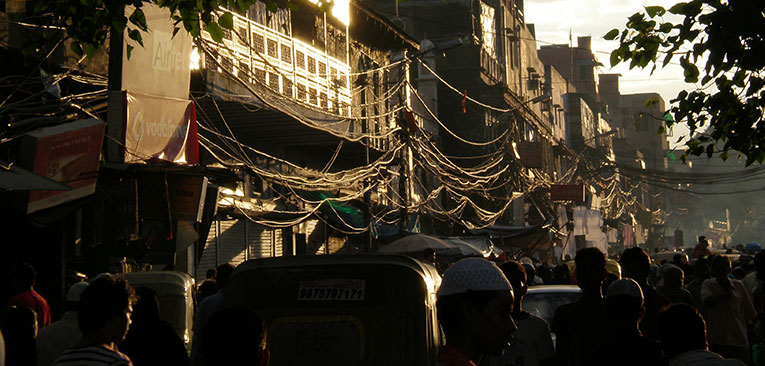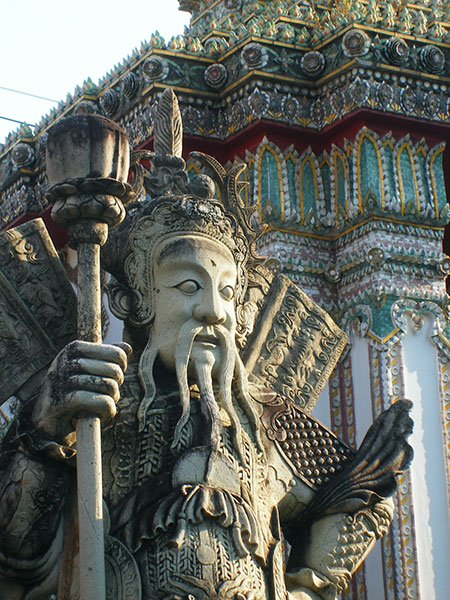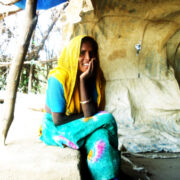Having lived in Delhi for more than a year now, the city seems to me to be contemporary in the singular nature of her oldness. Her density in terms of time; the multiple eras that have passed through her walls and streets—one might ask, how is this relevant to us today? How can antiquity, besides helping us stay in touch with history, know where we came from, appreciate the battles of our predecessors, wagera, wagera?
How can this teach us anything new? What message can a slew of old buildings and kilometres of crumbling, cramped neighbourhoods have for a soaring population of mostly young people, nearly all of whom are striving their “bestest” to be independent and alternative, contemporary, current, and cutting-edge?

Chandni Chowk. Photograph by Rachel Firestone.
I suggest that you simply take a walk outside. The fact that traces of Delhi’s history first, still exist, and second, remain relevant and vital parts of this city and the day-to-day lives of millions of people despite the rapid rise of high-rises, flyovers, exciting night-life, and rapid fire information technology, is telling. It suggests that the city has been able to simultaneously adapt and retain itself.
Delhi’s oldness is alternative to, independent of, but equally conscious and respectful of the new. Older parts of the city have made room for modern developments, many portions getting knocked down in the process, it is true. Yet much of it remains and, despite wear and tear, continues to be used as vital, functioning elements of a city—I believe for reasons that go beyond the Delhi Development Authority simply not yet having enough time or money to rebuild every single old area. Unlike Bukhara, Khiva, even parts of old Jerusalem, Delhi is not a museum—she is alive. Somehow, Delhi’s oldness has a continued relevance to contemporary pulse, and I think this healthy embracing of duality is an important lesson for us to learn from.

Chandni Chowk. Photograph by Rachel Firestone.
Several times since moving here, I have had the distinct sensation of being engaged in a Jacobean wrestling match with a metropolis. Day after day, as I am buffeted by the cultural, demographic, and political winds of this ancient city of seven cities, this ecstasy of urban sprawl, this capital of a nation of 1.18 billion people, 50% of which are under the age of 25, it is easy to see how Delhi’s bipolar qualities can be contagious.
Yet if I built a sand castle of all the good things of Delhi on one side and a pile of all the bad things on the other, and then if I distanced myself from them both and climbed up to my celestial mountain-top to look down on them, despite the mist threading down, settling on both piles, and threatening to obstruct my vision and my thoughts, I would say that, all in all, I love Delhi. I would say that the good has weighed out the bad, that this massive bundle of co-existing contradictions is precisely what has grown on me.
Yesterday I found the lost court of Aurangzeb, the sixth Mughal Emperor of India, called the “Last of the Great Mughals” by some, and also known as one of the most ferocious, ruthless, and bigoted He-Men of history.
I had finished work at one of my schools early and was on a walk to nowhere in particular. It was Saturday, early evening, and the streets and winding thoroughfares of Chandni Chowk were crowded, so much so that more than once I considered simply turning back and going home. My world became a colossal traffic jam of people, and for five eternal minutes, I stood locked in one place, my forehead pressed against the back of the man in front of me. I had somehow become part of a line of human bodies struggling to move through a tiny crack between two buildings, most of whom were completely disregarding the fact that one end of the crack was semi-permanently plugged by other bodies queuing up (and fighting) for world-famous, non-chained, 150-year-old recipe-ed dahi ballah.

A spitting image of the Sardar standing at the entrance to the courtyard. This photograph was taken at the Grand Palace in Bangkok, but the likeness is uncanny. Photograph by Rachel Firestone.
A few minutes later, heading down Dariba Kalan, known for its jewels, my breathing slowed, and the air cleared a bit as dark figures ducked in and out of glistening little shops, and bunches of laughing, fat-faced women huddled around sweet carts, savouring milk-cream soufflés covered in pistachio dust—a sweet that is made only for weddings and during this particular time of year, the last flurry of winter. On a whim, I swung into a tiny alley jutting off from Dariba, and the quality of the air suddenly changed. Colder, quieter, the air seemed thicker and heavier, the buildings older, and even the people around me moved slower. I even caught myself trying to breathe slower. Here, packing shops and boarded up public phone booths were framed by a series of baroque, embellished pillars and swirls of irises carved into old marble. An ancient, bearded Sardar stood before an opening in the wall-spread looming to my right. Over his shoulder I could see dainty arches, intricately carved jail screens, and ornate window frames across the abandoned courtyard inside. “What is this place?” I asked.
“It is Aurangzeb-ki-Adaalat—Aurangzeb’s court,” he answered. “They say they used to give out many judgements here.”
“Can I go inside?” I asked, and he nodded, the curls of his long white beard undulating over his chest like the tentacles of an octopus.
Inside, my feet crunched over rubble. Ornate pillars were strewn about, facedown, like partiers passed-out unconscious after a night of revelry. I looked up at a carved marble screen covering a window, the pots of a kitchen just visible through the holes. Making a 360-degree turn with my face turned upwards, I took in the decrepit arches and buttresses stubbornly continuing to soar up all around me. What it would be like to live in such a place, waking up every morning in the bedroom of a rani long gone, making chapatis and doing laundry in a courtyard where verdicts were given, and men got beheaded or crowned with estates? Circling the enclosure, I saw that nailed onto a delicately carved little blue doorframe in a back corner, written in black embossed letters, was a name plate which hailed, “Aisha Rani w/o (wife of) Sukhesh….[text wiped out here] Bhai. Residing here since 1852.” Obviously not here since Aurangzeb’s time, this nevertheless appeared to be a trace of one of Delhi’s older families. I stood there for a long time wondering what kind of woman Aisha Rani was or is. And then I turned away and sat on pillar to watch dust particles swirl in one last resilient beam of late-afternoon light.
Outside again, the Sardar was still standing at his post. “What is this place used for now?” I asked.
“Why, it is just an open space now. People still call it the Adaalat.”
“But I see signs for S.T.D. phone shops inside, are these doors shop fronts now?”
“No. One Bhai, an owner of one of the houses here, tried to keep that S.T.D. booth for a while, but now it is closed. Now people live around the courtyard in the houses, but that’s all. Some people want to change their houses, make them more modern, but most want to keep it like this—they feel it is their birthright. Anyway, it’s cheaper that way, na?” He grinned into his tentacles, and his eyes smiled.

Lion-head building façade on Kucha Sethi, off of Dariba Kalan, Chandni Chowk. Photograph by Rachel Firestone.
I thanked him and continued my walk. Moved by the silence of the place I had just been, I felt a strange quiet inside, I felt I was observing the crowds I had now returned to from within a protected bubble where no sound or touch could penetrate. Soon I moved off into another small alley, which curled in twists and turns until my sense of direction was lost completely. And suddenly, I was not in Mughal India anymore, but in a distinctly Jain community, dotted with pristine temples, schools, and prayer paraphernalia shops, the houses all a stark white, the streets unearthly clean. Little boys and girls with giant multi-coloured backpacks poured out of a school just in front of me, chattering and exchanging bubblegum wrappers as they moved down their individual alleyways. The carving and building ornamentation here was striking as well—though very different from the Mughal irises and colonnades I had just seen.
I turned down smaller and smaller lanes, my head looking up at the window panes and carved balconies. At a cul-de-sac folded in late-winter fog, two little boys walking home invited me into a courtyard, and I went inside—to see the inside of a Delhi joint-family manor for the first time. The grand enclosure and carved and painted plaster walls broke off into four or five different residences, most likely now owned or occupied by different, independent families. And though a bustling thoroughfare bubbled by some ten metres from where I stood, inside was a deep, marble ensconced quiet. People were just coming home, and the bustle of early evening had not yet started.
Further down the lane, another building spanned the entire block for at least 50 metres. Dark brown and dotted with stone inlay, this was one of the most beautiful manors I had ever seen in Delhi. On the ground floor was a D.V.D. shop, and I asked the man inside if he knew what this building used to be. He said it still belongs to the owner of the cleaners shop inside, who I could see was drinking chai behind the counter. I went in, and a burly man with a dingy but freshly pressed collared shirt and sparkly sweater vest rose up to great me. “Yes, this is my family’s house. We still live here, we occupy all four floors. No, it was never any other kind of building; it has always been a residence. In fact, our family has always lived here.” A teenage boy, wearing a matching sparkly sweater-vest came downstairs and joined him. “Years ago we used to be very wealthy,” he added in, “we were aristocrats.”
“What is your surname?” I asked.
“Jain—many of us have the surname Jain in this area.”
“Are there many families like yours here?”
“The community is old, and most of us have continued to stay. Why move out if we can live here, do well, and keep the place our families have always lived in? We sell all the new movies, my sons all go to college and university, but they want to keep living here.”
Then, once I continued and turned down another bend, I saw the grand highlight of my day. A huge, stone lion’s head jutting out from beside a samosa seller and across from a dry-goods shop. Entering the lion’s mouth, tripping over his teeth and literally stepping on his tongue took you inside, into a dingy common foyer, at the other end of which winked the electric lights and plastic marigold garlands of a temple. I laughed out loud, and the dry-goods walla turned to look at me and then glanced away, uninterested. Clearly, even the foreign girl with short hair who stops in front of lions and laughs to herself is not sufficiently strange to attract notice in a place like this. A man coughed loudly and split phlegm on the street two shops down, and one by one, lights blinked on at the store fronts. Night had come and the lion was just one of the many odd treasures to be found and admired in this city of lost dreams and found ones.








